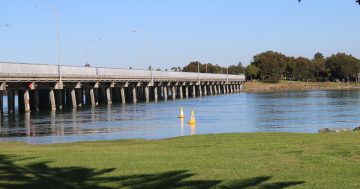
Gilmore MP Fiona Phillips in front of the old Nowra Bridge. Photo: Fiona Phillips.
It’s going to take more than a quick facelift, but work to turn the historic Nowra Bridge into a scenic pedestrian and cycling path has begun.
When it opened in 1881 the old bridge was the largest bridge project in NSW, designed by the former American civil engineer and specialist bridge engineer, C Shaler Smith.
It is the only American pin-jointed Whipple truss in service in NSW.
Sadly, after 140 years it is no longer able to keep up with traffic demand. The new Nowra Bridge was opened to traffic in February 2023 and major work on the project was completed in November 2023.
The original bridge is structurally sound, however, and work to repurpose it has begun.
The NSW Government estimates the four-stage project will take about three years to complete and, along with the Albanese Government, has invested $20 million to preserve this iconic part of the Shoalhaven’s heritage.
The first stage of work will include truss repairs, repairing the end truss lattices, repairs to the concrete bridge deck, removal of the old handrail connections and replacement of rosette style diagonal bracing washers.
This stage is anticipated to take about six months to complete, and will begin on Monday 11 November. Work will be carried out between 7 am and 6 pm, Monday to Friday, and 8 am to 1 pm on Saturdays.
Further stages of work will involve removal of the cantilevered footpath, prioritised repainting and installation of lighting.
The bridge will remain closed with street lighting switched off while work is carried out. Temporary fencing, signage, and security cameras will be in place to discourage pedestrians from accessing the bridge.
Federal Member for Gilmore Fiona Phillips said she was thrilled to see work begin.
State Member for South Coast Liza Butler said the Albanese and Minns Labor governments were delighted to be investing in the community project.
“The old bridge has worked hard over the years and it’s now in need of a lot of tender love and care to bring it back to its former glory,” she said.
Finishing work carried out in the past six months included building footpaths, finalising landscaping, removing excess spoil from the Bolong Road stockpile site, and removing and replacing contaminated mulch from several locations across the project.


















